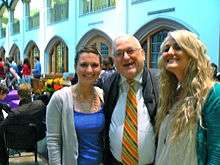Robert Edmund O'Malley
| Robert E. O'Malley | |
|---|---|
| Residence | Seattle, WA |
| Nationality | American |
| Fields | Mathematician |
| Institutions | University of Washington |
| Alma mater | University of New Hampshire Stanford University |
| Doctoral advisor | Gordon Eric Latta |
| Known for | Singular Perturbation Theory, Asymptotic Methods |
Robert Edmund O'Malley Jr. (born 1939) is an American mathematician.
Professor O'Malley studied electrical engineering and mathematics at the University of New Hampshire where he received his baccalaureate degree in 1960 and his master's in 1961. He then studied differential equations and singular perturbations at Stanford University where he received his doctorate in mathematics in 1966. After brief appointments at the University of North Carolina (Chapel Hill), Bell Telephone Laboratories, the Courant Institute (New York University), and the Mathematics Research Center (the University of Wisconsin, Madison), Professor O'Malley returned to New York University in 1968. He remained there, doing research on asymptotic methods and singular perturbations with J.B. Keller and a number of other stimulating colleagues and students. Professor O'Malley spent a year at the University of Edinburgh, where his lecture notes formed the basis of his book, Introduction to Singular Perturbations (Academic Press, 1974). In 1973, he moved to the University of Arizona (Tucson) where he later organized a successful interdisciplinary program in applied mathematics, and where he applied singular perturbation ideas in control theory. After a sabbatical at Stanford University, Professor O'Malley moved to Rensselaer Polytechnic Institute (Troy, New York) in 1981. At Rensselaer, he headed a mathematical sciences department which emphasized applied mathematics and computer science. There, he was active in campus affairs and served as the Chairman of the Faculty and the Ford Foundation Professor. Soon after a sabbatical at the Technical University of Vienna, where Professor O'Malley studied asymptotic methods in semiconductor modeling, he moved to the University of Washington, Seattle.
Professor O'Malley is currently at the University of Washington Department of Applied Mathematics as an emeritus faculty member. He served as the President of the Society for Industrial and Applied Mathematics (SIAM) [1] (1991-1992). In 2009 he became a SIAM Fellow.[2] In 2012 he became a fellow of the American Mathematical Society.[3]
Work
Professor O'Malley's current research emphasizes the relationship between singular perturbation theory and various regularization methods for differential-algebraic systems, geometric approaches to understanding the limiting solutions to singularly perturbed boundary value problems, the motion of shock layers and other interfaces, the interplay between asymptotic and numerical methods, and tough problems of asymptotic matching. He continues to collaborate with an international collection of interesting characters, and receives support for his scholarly work from the National Science Foundation.
O'Malley is known for several pioneering contributions to singular perturbation theory and applications.[4]
Professor O'Malley has been especially active as a member of SIAM, the Society for Industrial and Applied Mathematics. He was president of SIAM in 1991 and 1992, and has been vice-president in charge of their publication program which encompasses ten journals and several book series. Among his other positions with SIAM has been that of program chair for several meetings including ICIAM `91, the second international industrial and applied mathematics conference, which drew 2,200 participants.
Dr. O'Malley serves on a number of boards, including advisory committees for the National Institute of Standards and Technology, the Electric Power Research Institute, and Argonne National Laboratory, and more generally as a spokesperson for applied mathematics[5]

Selected publications
- On the motion of viscous shocks and the supersensitivity of their steady-state limits, Methods Applics. Analysis, 1, (1994), (with J.G.L. Laforgue).
- Shock layer movement for Burger's equation, SIAM J. Appl. Math. 54: (1994) (with J.G.L. Laforgue).
- On regularizing differential-algebraic equations, Trends and Developments in Ordinary Differential Equations, Y. Alavi and P.F. Hsieh, editors, World Scientific, 1994 (with L.V. Kalachev).
- The regularization of nonlinear differential-algebraic equations. SIAM J. Math Anal., 25: pp. 615–629, 1994 (with L.V. Kalachev).
- Super sensitive boundary value problems, "Asymptotic and Numerical Methods for Partial Differential Equations with Critical Parameters", H.G. Kaper and M. Garbey, editors, Kluwer, 1993, pp. 215–223 (with J.G.L. Laforgue).
- Singular Perturbation Methods for Ordinary Differential Equations, Springer-Verlag, New York, 1991.
References
External links
- Home Page at University of Washington
- Robert Edmund O'Malley at the Mathematics Genealogy Project
- http://www.siam.org/news/news.php?id=768